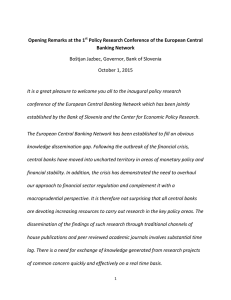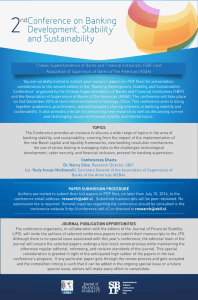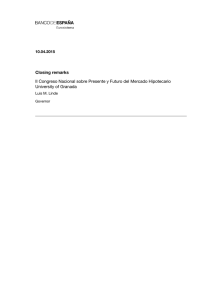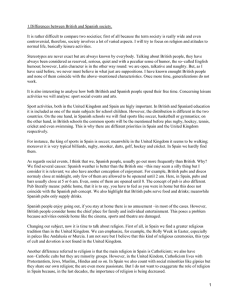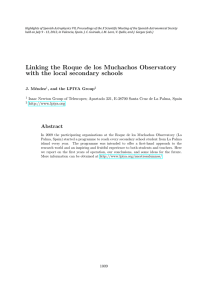Spanish banks: Measuring competitiveness against the European
Anuncio
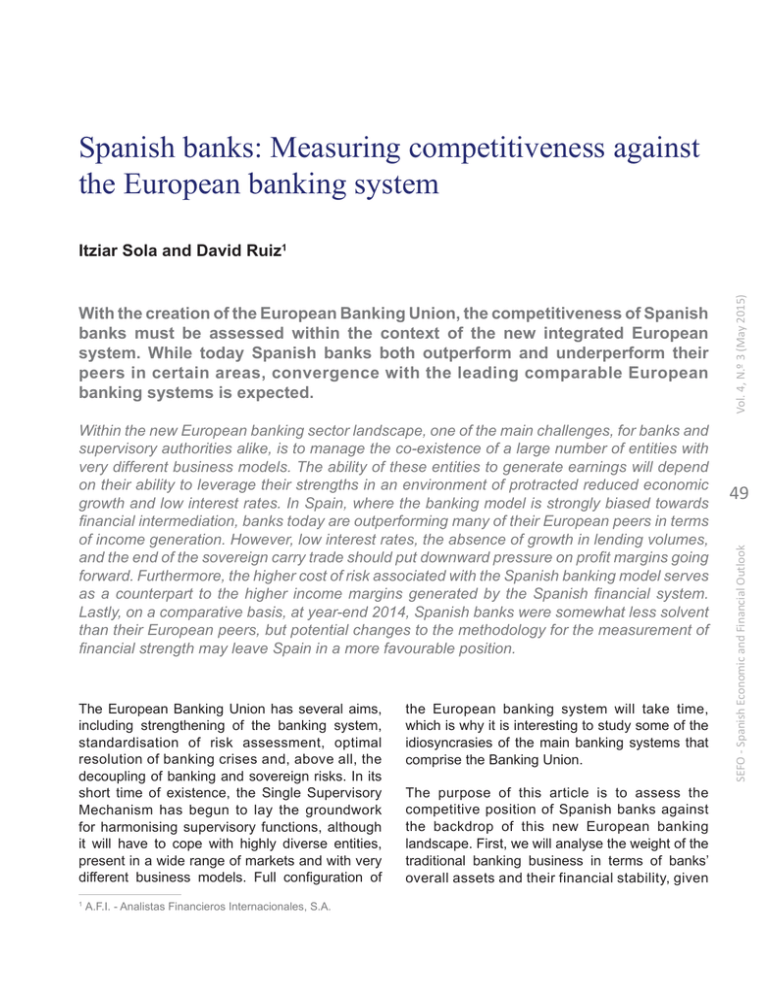
Spanish banks: Measuring competitiveness against the European banking system Within the new European banking sector landscape, one of the main challenges, for banks and supervisory authorities alike, is to manage the co-existence of a large number of entities with very different business models. The ability of these entities to generate earnings will depend on their ability to leverage their strengths in an environment of protracted reduced economic growth and low interest rates. In Spain, where the banking model is strongly biased towards financial intermediation, banks today are outperforming many of their European peers in terms of income generation. However, low interest rates, the absence of growth in lending volumes, and the end of the sovereign carry trade should put downward pressure on profit margins going forward. Furthermore, the higher cost of risk associated with the Spanish banking model serves as a counterpart to the higher income margins generated by the Spanish financial system. Lastly, on a comparative basis, at year-end 2014, Spanish banks were somewhat less solvent than their European peers, but potential changes to the methodology for the measurement of financial strength may leave Spain in a more favourable position. The European Banking Union has several aims, including strengthening of the banking system, standardisation of risk assessment, optimal resolution of banking crises and, above all, the decoupling of banking and sovereign risks. In its short time of existence, the Single Supervisory Mechanism has begun to lay the groundwork for harmonising supervisory functions, although it will have to cope with highly diverse entities, present in a wide range of markets and with very different business models. Full configuration of 1 A.F.I. - Analistas Financieros Internacionales, S.A. the European banking system will take time, which is why it is interesting to study some of the idiosyncrasies of the main banking systems that comprise the Banking Union. The purpose of this article is to assess the competitive position of Spanish banks against the backdrop of this new European banking landscape. First, we will analyse the weight of the traditional banking business in terms of banks’ overall assets and their financial stability, given 49 SEFO - Spanish Economic and Financial Outlook With the creation of the European Banking Union, the competitiveness of Spanish banks must be assessed within the context of the new integrated European system. While today Spanish banks both outperform and underperform their peers in certain areas, convergence with the leading comparable European banking systems is expected. Vol. 4, N.º 3 (May 2015) Itziar Sola and David Ruiz1 Itziar Sola and David Ruiz SEFO - Spanish Economic and Financial Outlook 50 Financial equilibrium: Liquidity One simple way to determine business models among different banking systems or among banks in a given system is to look at the structure of their assets and liabilities, as well as the implicit equilibrium between both. A balance sheet heavily biased towards loans and/or deposits suggests a business model that is skewed towards financial intermediation, as compared to models that are more oriented towards corporate and/or investment banking, which typically present significantly lower levels of loans and/or deposits. At the same time, the proportion of loans to deposits is another good indicator of the financial equilibrium with which the business model (whether wholesale or retail) is pursued. For the purpose of classifying banks by the aforementioned models, Exhibit 1 presents a broad sample of banks from various European countries classified by the relative weight of loans and deposits in their balance sheet structures. Unlike German and French banks, Spanish and Italian banks are heavily exposed to the traditional intermediation business, albeit with a substantial loan-to-deposit gap. Despite substantial dispersion among the entities considered, certain patterns or clusters emerge that enable categorisation of the various systems. The majority of Italian and Spanish banks, for example, present a similar profile. Specifically, significant exposure to financial intermediation (loans and deposits), albeit with an element of financial imbalance, insofar as loans slightly outweigh deposits. British banks also display bias Exhibit 1 Business models of European banks (December 2013) (Percentage) 90% Loans / Assets Vol. 4, N.º 3 (May 2015) its importance for liquidity management. We devote the second section to an examination of income generation and cost efficiency, measures that are vital to ensure the business’s long-term sustainability. We then assess banks’ different risk profiles. Lastly, before drawing our conclusions, we will analyse the main European banking systems from the standpoint of capital adequacy and solvency. 70% 50% 30% 10% 10% 20% 30% 40% 50% 60% 70% 80% Deposits / Assets Germany Source: AFI, using data obtained from SNL. Spain France Italy UK 90% Spanish banks: Measuring competitiveness against the European banking system At the other end of the spectrum lie German and French banks with far less exposure to intermediation, implying greater concentration on capital markets and investment banking activities. French banks are more balanced, while German banks, whose loans outnumber their deposits, are more clearly out of sync. Nevertheless, the gap between loans and deposits has narrowed substantially in all countries, above all in Spain, since the start of the crisis. Recall that at the start of the crisis, the loan-to-deposit ratio in Spain stood at 150%, implying that loans were not fully funded by deposits so that banks were relying heavily on the wholesale funding markets. The collapse of these markets between 2008 and 2012 (indeed, until the ECB reactivated bank liquidity) evidenced the risk entailed by such an imbalanced financial position and drove a shift towards a more balanced loan-to-deposit structure. Income generation and cost efficiency Our business model analysis would be incomplete without an assessment of Spanish banks’ competitiveness. To this end, we first compare the margins generated by banks on a comparative basis and the costs incurred in doing so. Obviously, these metrics will differ significantly from one entity to the next so that their aggregation across entities must be interpreted with caution, as these figures encompass starkly different realities. With these caveats in mind, Exhibit 2 compares Spanish banks with their main European peers in terms of two key ratios (as of June 2014, the most recent figures available). On the one hand, the gross operating income2 generated by banks, expressed as a percentage of average total assets, and, on the other, the total operating costs3 incurred to manage these assets and generate the corresponding gross margin. Vol. 4, N.º 3 (May 2015) towards intermediation, in this instance presenting greater balance between loans and deposits. 51 Margins and costs across Europe’s banking systems (June 2014) Business profitability (gross operating income/ATA) Cost structure (operating costs/ATA) 1.78 3.00 1.47 2.95 2.14 1.38 1.25 1.16 1.93 1.58 Italy Spain France UK Germany Source: ECB Banking Consolidated Data, AFI. Italy Spain France UK Germany Source: ECB Banking Consolidated Data, AFI. Gross operating income is the arithmetic sum of all financial income (that generated by banks’ lending activities and from their investments in fixed income securities and equities), less financial costs (the cost of customer deposits and other liabilities issued), plus net fee and commission income, service revenue and net trading gains. In the case of non-financial corporates, the gross margin is equivalent to gross profit. 2 Operating costs refer to the costs incurred to run the business and include personnel costs, other operating costs and depreciation and amortisation charges. 3 SEFO - Spanish Economic and Financial Outlook Exhibit 2 Itziar Sola and David Ruiz Vol. 4, N.º 3 (May 2015) As the exhibit reveals, the Spanish banking system generates a higher gross operating income than its counterparts in the other major European economies, with the exception of Italy. SEFO - Spanish Economic and Financial Outlook 52 Italy is the country with the most costly banking system (measured relative to its asset volumes) among the major European economies, largely eliminating its advantage in terms of margin. In the case of Spain, in contrast, the difference with the other three major economies in terms of costs is very small, which means it leverages its margin advantage. Indeed, the difference between gross The Spanish banking system presents the highest spread between gross margin and opex (1.48% of ATA) among the large European economies. operating income and operating costs (1.48% of assets) is higher in Spain than in any other large European economy. However, it would be premature to conclude from this comparative analysis that Spanish banks boast a more favourable competitive position than their peers in Europe’s largest economies for several reasons. First of all, their ability to continue to generate such a high gross operating income going forward is questionable in an environment marked by protracted low interest rates and the absence of growth in lending volumes. Secondly, the gross margins generated in 2014 (as in 2012 and 2013) include very significant sums, most particularly in Spain and Italy, whose recurrence is highly unlikely. Specifically, we refer here to the income generated by the socalled carry trade, namely the profit generated by borrowing money from the European Central Bank at ultra-low rates and investing it in sovereign bonds yielding much higher rates. This phenomenon made a far larger contribution to gross operating income in Spain and Italy for two main reasons. On the one hand, because these two countries’ sovereign bonds have been offering far higher yields than those of the other major European economies, translating into a substantially higher unit margin. Moreover, the intensity with which these two nations’ banks invested in sovereign bonds was more pronounced, as can be seen in Exhibit 3. Exhibit 3 illustrates the relative weight of sovereign bond investments in the assets of the banks of the major European economies at year-end 2014. Italy and Spain clearly top this particular ranking, presenting weightings slightly above 10% in both cases. We can unequivocally state that the contribution made by these investments to gross operating income in these two countries is much higher than the 10.5% of assets represented by these public debt holdings. This is due to the fact that the unit margin on these investments, financed at a rate of virtually 0%, was considerably higher than that obtained on the banks’ other investments, including customer loans. Exhibit 3 Public debt holdings as a % of assets. European banking systems (2014) 10.6 10.5 4.4 3.3 1.9 Italy Spain Germany France UK Source: ECB, AFI. In order to ring-fence to the extent possible the caveats mentioned in terms of the cross-country comparability of margins, we have tried to break down gross operating income further in an attempt Spanish banks: Measuring competitiveness against the European banking system Exhibit 4 Breakdown of gross margin across Europe’s banking systems (June 2014) Operating income / ATA (Percentage) 3.0 3.0 1.0 0.8 0.3 0.5 2.8 -1.3 Italy 2.1 0.7 0.4 3.3 -1.5 Spain 2.3 -1.2 France Interest income fees&commissions Net fees & commissions 1.6 1.9 0.7 0.1 0.7 0.3 2.2 1.7 -0.7 UK Under the prevailing regulatory framework, these different risks have to be measured by each entity using different approaches –standard or based on internal ratings– albeit with a common objective, that of synthesising each entity’s risk profile, expressed as the percentage of riskweighted assets (RWA) relative to that entity’s total assets. The higher this ratio, the higher an entity’s risk exposure insofar as they present a relatively higher weighting of risky assets for RWA calculation purposes, which in turn is the basis for a firm’s capital requirements. Exhibit 5 illustrates the aggregate risk profile as of June 2014 of the banking systems of the Eurozone’s four largest economies, along with the United Kingdom, clearly evidencing two welldifferentiated lines of specialisation. Spain and Italy also top this ranking, with RWA ratios close to 50%, while Germany and France present far less risky profiles, with RWA ratios around 35% of total assets. The UK stands closer to France´s and Germany’s levels of risk. Exhibit 5 Risk profile (RWA/TA) - European banking systems (June 2014) -1.4 46.8 Germany Interest expense Other income 34.5 35.3 36.7 France UK Germany 50.3 Source: ECB, AFI. Risk profile and risk-adjusted returns The comparative analysis of the profitability and cost metrics relative to assets would be incomplete without taking into account the different risk profiles assumed by the various entities in pursuing their business models. The system encompasses markedly different business models and a broad Source: ECB, AFI. Spain Italy Vol. 4, N.º 3 (May 2015) range of attendant risks that need to be correctly identified, measured and managed. 53 SEFO - Spanish Economic and Financial Outlook to indirectly pinpoint business specialisation in one or another area. As shown in Exhibit 4, the Spanish banking system presents the margin structure (by component) that most closely resembles that of a business model based on traditional financial intermediation. Spanish banks’ margin structure is far less exposed to trading and derivative related income (the main components of ‘Other’); on the other hand, Spain is the country with the highest weight of both financial income (interest income) and financial costs (interest expense). The relatively higher incidence of financial income and costs in gross income can reflect a business structure more heavily weighted towards loans and deposits and/or the assumption of higher risk in their business activities, whether retail or wholesale. Itziar Sola and David Ruiz Vol. 4, N.º 3 (May 2015) Unquestionably, as we will demonstrate further on, the less risky profile of banks in Germany and France is largely influenced by the business specialisation of their major global banks. This specialization is characterised by a very low incidence of traditional financial intermediation and relatively high exposure to capital markets activities, which carry reduced weightings for capital adequacy calculation purposes. SEFO - Spanish Economic and Financial Outlook 54 We must consider the argument that the coefficients used to weight assets for RWA purposes are debatable and the international debate is moving in favour of requiring banks to hold capital as a function of their total assets and not only their risk-adjusted assets (i.e., requiring a leverage ratio in addition to a minimum capital ratio). Nonetheless, it is true that the different risk profiles of the Spanish and Italian banks and the German and French banks most likely reflect higher exposure to lending activities in the The differences in the risk profiles of Spanish and Italian banks (50%) relative to their German and French counterparts (35%) probably reflect higher relative exposure to lending activities in the former. former. Against the backdrop of the recent crisis, this exposure will have translated into higher provisions for risks in general and for loan losses in particular. This is evident if we analyse Exhibit 6, which depicts the year-on-year trend since the start of the crisis in the cost of risk assumed by the main European banking systems. This cost of risk is primarily reflected in the provisions recognised by banks in each year, expressed as a percentage of total assets. We have taken a period spanning several years, as well as the year-onyear snapshot, because the various banking systems, and even the various banks within a given system, may have timed their recognition of this cost differently. This could be due to respective prudential requirements (different in each country albeit identical for each entity within a given system), or as a result of the kinds of risks predominating in each bank’s asset structure. These different timing patterns explain the markedly different trend in terms of when each country recognised this cost of risk for accounting purposes (asset impairment losses charged against profits). Whereas these losses were largely recognised at the start of the crisis (2008 and 2009) in Germany, France and the UK, in Spain and Italy, they were recognised much further into the crisis (2011 and 2012 in Spain and a year later still in Italy). This same exhibit presents the annual trend in net income (i.e., after deduction of this cost of risk), similarly expressed as a percentage of total assets, namely, the return on assets (ROA) ratio. As might be expected, the trend in banks’ ROA is clearly inversely related to the cost of risk: when this increases, it exerts downward pressure on returns. In fact, in nearly all the countries analysed, with the sole exception of France, the year in which the cost of risk peaked translated into aggregate losses for the banking system as a whole (negative ROA). This occurred in Germany and the UK in 2008 and 2009, in Spain in 2012, and in Italy in 2011, 2012 and 2013. In addition to the timing differences with respect to recognition of these provisions for accounting purposes, Exhibit 6 shows that the impact was Beyond the timing differences, the annual cost of risk averaged around 1.15% of total assets in Spain and Italy, compared to an average of 0.3% in France and Germany. much higher in Spain and Italy than in Germany or France. In the first two countries, this cost of risk averaged around 1.15% of total assets per Spanish banks: Measuring competitiveness against the European banking system Exhibit 6 Cost of risk (impairment losses/TAA) - European banking systems Germany France 1.0 1.0 0.8 0.8 0.6 0.6 0.2 0.2 0.0 0.0 -0.2 -0.2 -0.4 -0.4 -0.6 2008 2009 2010 2011 2012 2013 Jun-2014 41791 United Kingdom 2009 2010 2011 2012 2013 Jun-2014 41791 Spain 1.0 3.0 0.8 2.5 55 2.0 0.6 1.5 0.4 1.0 0.2 0.5 0.0 0.0 -0.5 -0.2 -1.0 -0.4 -0.6 2008 -1.5 2008 2009 2010 2011 2012 Jun-2014 2013 41791 -2.0 2008 2009 Italy 3.0 2.5 2.0 1.5 1.0 0.5 0.0 -0.5 -1.0 -1.5 -2.0 2008 2009 2010 2011 2012 2013 Jun-2014 41791 Cost of risk 0 0 0 0 0 0 Source: ECB Banking Consolidated Data, AFI. ROA 0 0 0 0 0 0 2010 2011 2012 Jun-2014 2013 41791 SEFO - Spanish Economic and Financial Outlook -0.6 Vol. 4, N.º 3 (May 2015) 0.4 0.4 Itziar Sola and David Ruiz Exhibit 7 Business margin and risk profile. Sample of European banks (2014) (Percentage) Operating income / Total assets Vol. 4, N.º 3 (May 2015) 4.0% 3.5% 3.0% 2.5% 2.0% 1.5% 1.0% 0.5% 10% 20% 30% 40% 50% 60% 70% 80% 90% RWA / Total assets Germany Spain France Italy UK Source: SNL, AFI. SEFO - Spanish Economic and Financial Outlook 56 annum, compared to an average of around 0.30% in the cases of Germany and France. This higher cost of risk in Spain throughout the crisis years is consistent with —or better said the consequence of— the system’s far riskier profile, which in turn serves as a counterpart to the higher income margins generated by the Spanish financial system. Against this backdrop, in order to confirm the correlation between business profitability and risk profile, we took our analysis of the banking systems as a whole and of certain individual banks a little further. Exhibit 7 presents risk profiles (RWA as a percentage of total assets) and gross margins, similarly expressed as a percentage of assets, of a large sample of banks across the major European countries. This analysis yields several conclusions. Firstly, the correlation between risk profile and margin generation is positive and highly significant, consistent with the risk-return trade-off. Secondly, looking at banks’ business presence by country of origin, there is a clear pattern of specialisation: most of the Spanish and Italian banks feature in the upper right-hand quadrant (high risk profile, high margin), while the French, British and German banks tend to cluster in the lower quadrant, albeit evidencing far greater dispersion in the case of the German banks. In their case, there is really no correlation between risk profile and margin generation in this instance. This anomaly among the German banks, which are precisely the entities that systematically evidence lower risk profiles, coupled with criticism regarding their excessive sensitivity to highly subjective internal models, is behind the growing clamour for the use of total assets (and not just risk-adjusted assets) for determining capital requirements in Europe. Solvency and leverage The most important indicator of banks’ financial health is their capital adequacy. In fact, the major mistake made during the early stages of the banking crisis in general, and in Spain in particular, was the belief that the crisis was largely a liquidity issue, when the real problem was one of capital shortage. Spanish banks: Measuring competitiveness against the European banking system Exhibit 8 Solvency and leverage - European banks (December 2014) (Percentage) Leverage (CET1/total assets) 6.0 13.0 12.8 11.8 5.9 5.3 11.6 4.6 4.0 Germany UK France Italy Spain Spain Italy Source: ECB, AFI. Source: ECB, AFI. This is why in addition to the public recapitalisation exercises undertaken across Europe, a large number of European banks had to take internal measures (whether to increase capital or reduce loan exposure and RWAs) in order to boost their solvency and pass the stress tests performed prior to the introduction of the Single Supervision Mechanism. Conclusions On a comparative basis, at year-end 2014, Spanish banks were somewhat less solvent than their peers in the other large European economies. Specifically, as illustrated in the bar exhibit on the left within Exhibit 8, banks’ Common Equity Tier 1, or CET1, ratio, expressed as a percentage of total risk weighted assets as of that date, was 11.6% in Spain, slightly lower than in Italy but well below the average in France and, above all, Germany. However, if financial strength is not measured in terms of RWA but rather in proportion to total assets, in line with the emerging international trend, particularly in the US, Spain and Italy clearly fare better than France and Germany, as is evident in the right-hand bar exhibit. Germany UK Vol. 4, N.º 3 (May 2015) 14.5 France Banking Union implies above all an irreversible commitment to building a fully-integrated banking system. The competitive landscape in which Europe’s banks are going to operate under must begin to factor in the new integrated system to which the Banking Union aspires and commits. Despite substantial dispersion among Europe’s banks, certain patterns emerge that enable categorisation of the various systems. Against this backdrop, the majority of the Spanish and Italian banks present very similar characteristics, strongly biased towards financial intermediation and marked by a gap between loans and deposits in the process of being corrected. In contrast, the traditional intermediation business holds much less weight among the French and German banks, whose models are more heavily dominated by capital markets and investment banking activities. Our analysis of Spanish banks’ competitive positioning relative to their peers in the other 57 SEFO - Spanish Economic and Financial Outlook Capital adequacy (CET1/RWA) Vol. 4, N.º 3 (May 2015) Itziar Sola and David Ruiz SEFO - Spanish Economic and Financial Outlook 58 large European economies begins with an examination of their ability to generate gross operating income. Spain ranks towards the top of this particular European league table, although income in recent years has included significant sums whose recurrence is considered highly unlikely. Specifically, we refer here to the income generated by the so-called carry trade, namely the profit generated by borrowing money from the European Central Bank at ultra-low rates and investing it in sovereign bonds yielding far higher rates. The significant correction already sustained in Spanish sovereign bond yields suggests that it will be far more challenging to pull off such carry trades in the future without incurring excessive risk. Moreover, the ability to continue to generate such high gross income margins may similarly be jeopardised by the protracted period of low interest rates and absence of growth in loan books. This will unquestionably exert downward pressure on Spanish banks’ net interest margins as part of clear-cut convergence with the leading comparable European banking systems. Irrespective of the sustainability of the marginderived competitive advantage boasted by the Spanish banking system, it is true that Spain’s banks generate their profits using a cost structure (relative to total assets) that is very similar to that of the other main European banking systems. This implies a degree of elbow room in terms of absorbing potential additional margin contraction. Indeed, the difference between gross operating income and operating costs is higher in Spain than in any other large European economy. The annual trend in net income (i.e., after deducting the cost of risk), also expressed as a percentage of total assets, a measure known as the return on assets (ROA), clearly presents inverse correlation with the cost of risk: when the provisioning effort increases, ROA comes under heavy pressure. In fact, in most of the countries analysed, the year in which the cost of risk peaked translated into aggregate losses for the banking system as a whole (negative ROA). This occurred in Germany and the UK in 2008 and 2009, in Spain in 2012, and in Italy in 2011, 2012 and 2013. Beyond different timing patterns with respect to recognition of provisions for accounting purposes, the cost of risk has been systematically higher in Spain and Italy than in Germany or France. This higher cost of risk in Spain throughout the crisis years is consistent with —or better said the consequence of— the system’s riskier profile, which in turn serves as the counterpart to the higher income margins generated by the Spanish financial system. Lastly, at year-end 2014, Spanish banks were somewhat less solvent than their peers in the other large European economies. However, if financial strength is not measured in terms of RWA but rather in proportion to total assets, in line with the emerging international trends, Spain and Italy clearly fare better on solvency than France and Germany.
